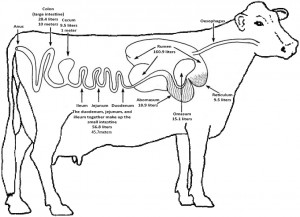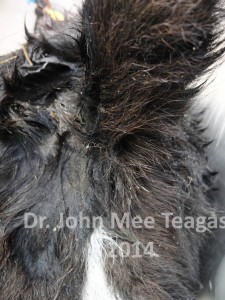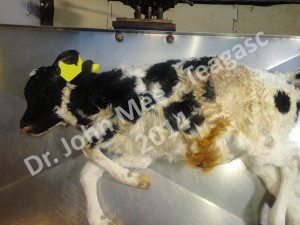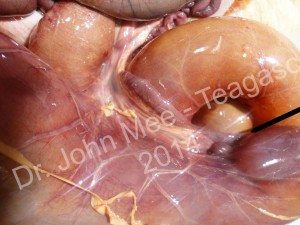Atresia is a genetic defect found in many mammals. Calves with a blocked bowel either have no anal opening (no back passage – atresia ani) or have a part of their guts blocked (atresia jejuni, atresia coli). Blockage of the guts is much more common in calves. The waterbelly is due to the build up of gut fluids in the unborn calf during pregnancy.
A calf with atresia will usually be born normally and seem like any other calf until after its first suck or feed of beastings (colostrum). Some affected calves will have a large belly and cause a difficult calving. After its first feed it will remain full, pass no faeces and decline to suck further. It may go down, pant, swell up, kick in pain or be found dead at 2-7 days old. This is an extremely painful condition.
Once suspected your local vet should be called to decide what to do with the calf.
Dosing with liquid paraffin or inserting a probe up the back passage will have no positive effect and may cause painful injuries. In cattle it is thought that atresia coli is the most common form, but research at Teagasc Moorepark carried out by Dr. John Mee has found atresia jejuni is the more common form in Ireland. Thus ICBF and Irish farmers need to know whether there is a genetic cause of this condition in our herds.

ICBF together with Teagasc and the Regional Vet Labs are looking for the genes responsible for atresia, but need farmer and veterinary help.
If a calf dies of suspected atresia, please submit the carcass to your local Regional Vet Lab if possible.
The more affected animals we get samples from, the more likely we’ll be able to find the genes that cause the problem in cattle so we can prevent it from happening in the future. The best animals to get tissue or hair samples from are ones that will be going for post-mortem so that we can determine what sort of atresia is present and also how many blockages there are in the animal, but as with any possible congenital defect, all reports and samples are appreciated. If you would like to report any defects including atresia, please fill out the congenital defects survey (Click here!) and send pictures to Jennifer McClure at [email protected]
Below are images taken by John Mee at Teagasc of the atresia cases he has had submitted to Moorepark.



Thank you to John Mee of Teagasc and Seamus Fagan of the Kilkenny RVL for their input on this post!
